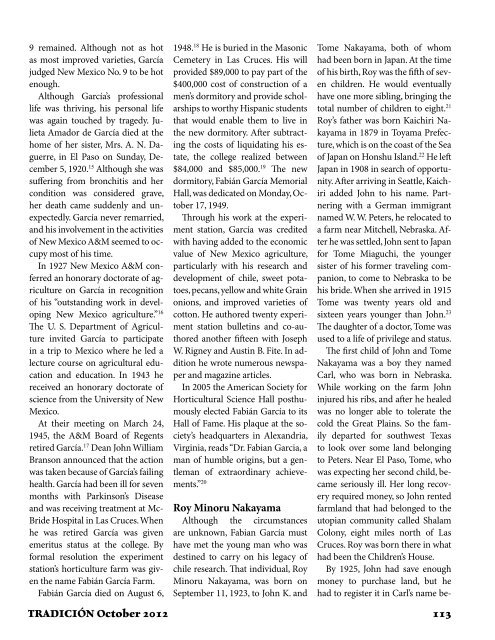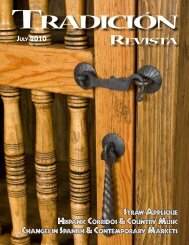tradicion revista fall 2012 - LPD Press & Rio Grande Books
tradicion revista fall 2012 - LPD Press & Rio Grande Books
tradicion revista fall 2012 - LPD Press & Rio Grande Books
Create successful ePaper yourself
Turn your PDF publications into a flip-book with our unique Google optimized e-Paper software.
9 remained. Although not as hot<br />
as most improved varieties, García<br />
judged New Mexico No. 9 to be hot<br />
enough.<br />
Although García’s professional<br />
life was thriving, his personal life<br />
was again touched by tragedy. Julieta<br />
Amador de García died at the<br />
home of her sister, Mrs. A. N. Daguerre,<br />
in El Paso on Sunday, December<br />
5, 1920. 15 Although she was<br />
suffering from bronchitis and her<br />
condition was considered grave,<br />
her death came suddenly and unexpectedly.<br />
García never remarried,<br />
and his involvement in the activities<br />
of New Mexico A&M seemed to occupy<br />
most of his time.<br />
In 1927 New Mexico A&M conferred<br />
an honorary doctorate of agriculture<br />
on García in recognition<br />
of his “outstanding work in developing<br />
New Mexico agriculture.” 16<br />
The U. S. Department of Agriculture<br />
invited García to participate<br />
in a trip to Mexico where he led a<br />
lecture course on agricultural education<br />
and education. In 1943 he<br />
received an honorary doctorate of<br />
science from the University of New<br />
Mexico.<br />
At their meeting on March 24,<br />
1945, the A&M Board of Regents<br />
retired García. 17 Dean John William<br />
Branson announced that the action<br />
was taken because of García’s failing<br />
health. García had been ill for seven<br />
months with Parkinson’s Disease<br />
and was receiving treatment at Mc-<br />
Bride Hospital in Las Cruces. When<br />
he was retired García was given<br />
emeritus status at the college. By<br />
formal resolution the experiment<br />
station’s horticulture farm was given<br />
the name Fabián García Farm.<br />
Fabián García died on August 6,<br />
1948. 18 He is buried in the Masonic<br />
Cemetery in Las Cruces. His will<br />
provided $89,000 to pay part of the<br />
$400,000 cost of construction of a<br />
men’s dormitory and provide scholarships<br />
to worthy Hispanic students<br />
that would enable them to live in<br />
the new dormitory. After subtracting<br />
the costs of liquidating his estate,<br />
the college realized between<br />
$84,000 and $85,000. 19 The new<br />
dormitory, Fabián García Memorial<br />
Hall, was dedicated on Monday, October<br />
17, 1949.<br />
Through his work at the experiment<br />
station, García was credited<br />
with having added to the economic<br />
value of New Mexico agriculture,<br />
particularly with his research and<br />
development of chile, sweet potatoes,<br />
pecans, yellow and white Grain<br />
onions, and improved varieties of<br />
cotton. He authored twenty experiment<br />
station bulletins and co-authored<br />
another fifteen with Joseph<br />
W. Rigney and Austin B. Fite. In addition<br />
he wrote numerous newspaper<br />
and magazine articles.<br />
In 2005 the American Society for<br />
Horticultural Science Hall posthumously<br />
elected Fabián García to its<br />
Hall of Fame. His plaque at the society’s<br />
headquarters in Alexandria,<br />
Virginia, reads “Dr. Fabian Garcia, a<br />
man of humble origins, but a gentleman<br />
of extraordinary achievements.”<br />
20<br />
Roy Minoru Nakayama<br />
Although the circumstances<br />
are unknown, Fabian García must<br />
have met the young man who was<br />
destined to carry on his legacy of<br />
chile research. That individual, Roy<br />
Minoru Nakayama, was born on<br />
September 11, 1923, to John K. and<br />
Tome Nakayama, both of whom<br />
had been born in Japan. At the time<br />
of his birth, Roy was the fifth of seven<br />
children. He would eventually<br />
have one more sibling, bringing the<br />
total number of children to eight. 21<br />
Roy’s father was born Kaichiri Nakayama<br />
in 1879 in Toyama Prefecture,<br />
which is on the coast of the Sea<br />
of Japan on Honshu Island. 22 He left<br />
Japan in 1908 in search of opportunity.<br />
After arriving in Seattle, Kaichiri<br />
added John to his name. Partnering<br />
with a German immigrant<br />
named W. W. Peters, he relocated to<br />
a farm near Mitchell, Nebraska. After<br />
he was settled, John sent to Japan<br />
for Tome Miaguchi, the younger<br />
sister of his former traveling companion,<br />
to come to Nebraska to be<br />
his bride. When she arrived in 1915<br />
Tome was twenty years old and<br />
sixteen years younger than John. 23<br />
The daughter of a doctor, Tome was<br />
used to a life of privilege and status.<br />
The first child of John and Tome<br />
Nakayama was a boy they named<br />
Carl, who was born in Nebraska.<br />
While working on the farm John<br />
injured his ribs, and after he healed<br />
was no longer able to tolerate the<br />
cold the Great Plains. So the family<br />
departed for southwest Texas<br />
to look over some land belonging<br />
to Peters. Near El Paso, Tome, who<br />
was expecting her second child, became<br />
seriously ill. Her long recovery<br />
required money, so John rented<br />
farmland that had belonged to the<br />
utopian community called Shalam<br />
Colony, eight miles north of Las<br />
Cruces. Roy was born there in what<br />
had been the Children’s House.<br />
By 1925, John had save enough<br />
money to purchase land, but he<br />
had to register it in Carl’s name be-<br />
TRADICIÓN October <strong>2012</strong> 113




